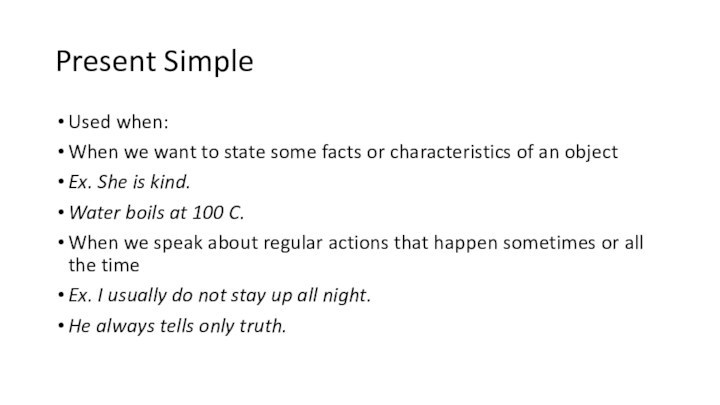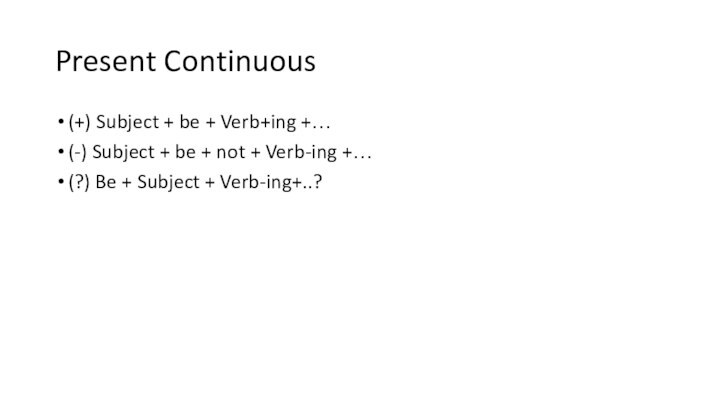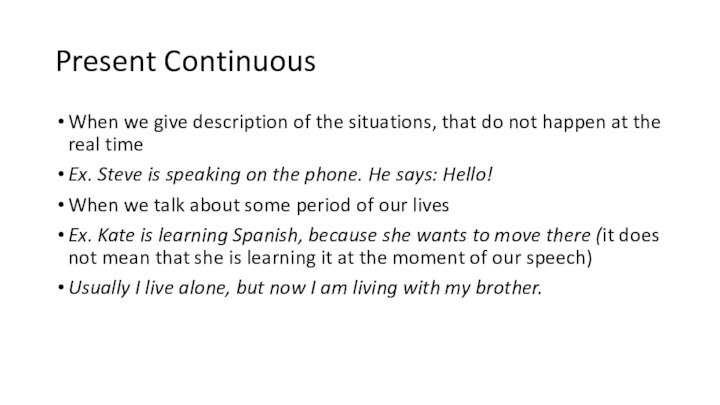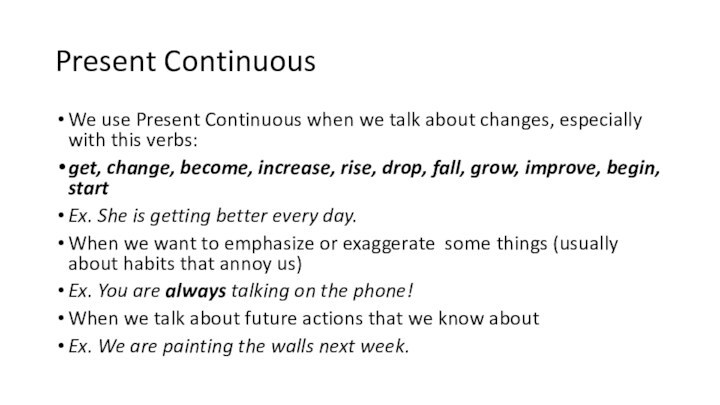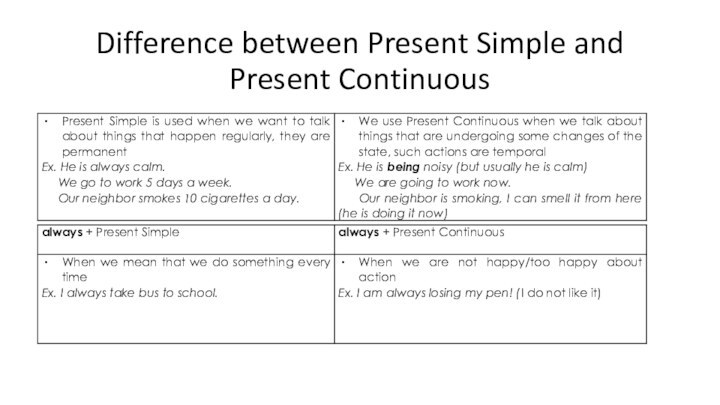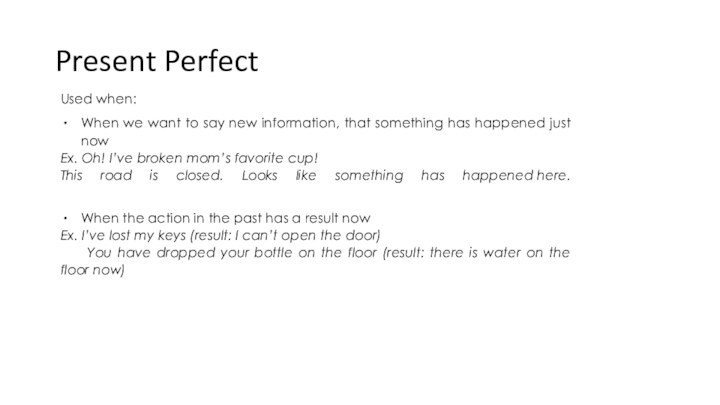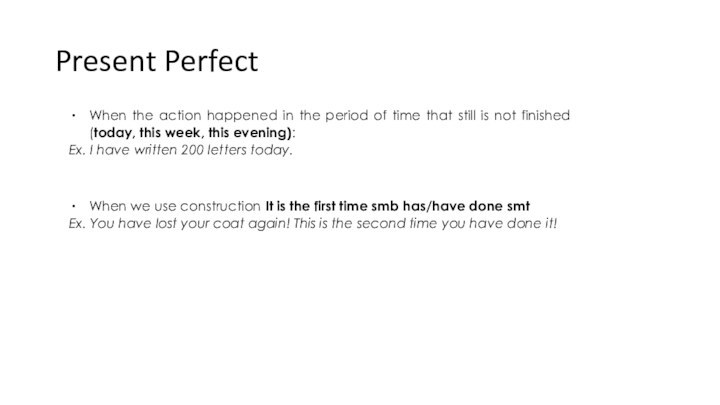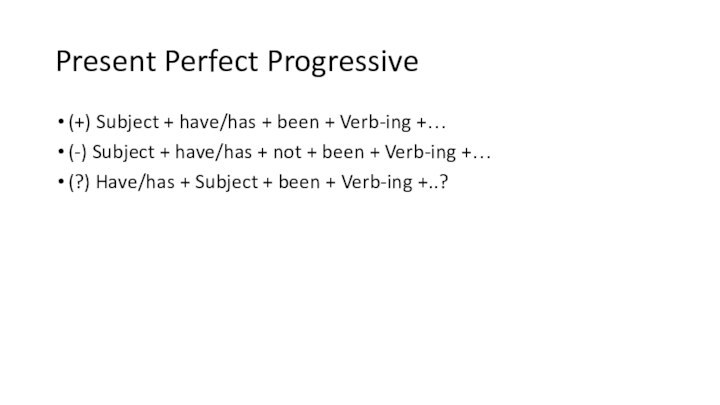Слайд 2
Present Simple
(+) Subject (noun/pronoun) + Verb (Verb +
s/es if 3rd person singular) +…
(-) Subject + do/does
+ not + Verb (infinite form with out to)
(?) Do/Does + Subject + Verb (infinite form with out to)
Слайд 3
Present Simple
Used when:
When we want to state some
facts or characteristics of an object
Ex. She is
kind.
Water boils at 100 C.
When we speak about regular actions that happen sometimes or all the time
Ex. I usually do not stay up all night.
He always tells only truth.
Слайд 4
Present Simple
When we mention schedules (time of arrival/leaving
of trains, airplanes, etc.)
Ex. Our train arrives in 15
minutes.
When the verb can not be used in progressive aspect
Ex. I see you right now.
In some cases we use Present Simple in the articles when we talk about some past actions
Ex. Local man saves the family from fire.
Слайд 5
Markers of Present Simple
always всегда
often часто
usually
обычно
sometimes иногда
regularly постоянно
seldom изредка
from time
to time время от времени
rarely редко
never никогда
every day каждый день
every week каждую неделю
every month каждый месяц
every year каждый год
on Mondays по понедельникам
at the weekend на выходных
at weekends по выходным
at 7 o'clock в 7 часов
Слайд 6
Present Continuous
(+) Subject + be + Verb+ing +…
(-)
Subject + be + not + Verb-ing +…
(?) Be
+ Subject + Verb-ing+..?
Слайд 7
Present Continuous
Used when:
When we speak about actions
that are happening at the moment of speech
Ex. I
am writing an essay, please, don’t bother me.
When we talk about actions that are not finished yet – a doer of the action is in the middle of it: they started it in the past, they are still doing it, the action is not finished yet.
Ex. She is cooking her favorite dish.
Слайд 8
Present Continuous
When we give description of the situations,
that do not happen at the real time
Ex. Steve
is speaking on the phone. He says: Hello!
When we talk about some period of our lives
Ex. Kate is learning Spanish, because she wants to move there (it does not mean that she is learning it at the moment of our speech)
Usually I live alone, but now I am living with my brother.
Слайд 9
Present Continuous
We use Present Continuous when we talk
about changes, especially with this verbs:
get, change, become, increase,
rise, drop, fall, grow, improve, begin, start
Ex. She is getting better every day.
When we want to emphasize or exaggerate some things (usually about habits that annoy us)
Ex. You are always talking on the phone!
When we talk about future actions that we know about
Ex. We are painting the walls next week.
Слайд 10
Markers of Present Continuous
now сейчас
still всё ещё
at the moment в данный момент
always всегда
constantly постоянно
Слайд 11
Difference between Present Simple and Present Continuous
Слайд 12
Stative Verbs
Verbs that we normally do not use
in progressive aspect:
denoting feelings: like, love, hate, want, need,
prefer
mental activity: know, realize, suppose, mean, understand, remember
denoting state of object: consist, seem, contain, belong, fit
Слайд 13
We can use some verbs that we do
not usually use in progressive aspect when they change
their meaning
Слайд 14
Present Perfect
(+) Subject + have/has + Verb (-ed
or irregular form) + …
(-) Subject + have/has +
not + Verb (-ed or irregular form) + …
(?) Have/has + Subject + Verb (-ed or irregular form) + ..?
Слайд 18
Markers of Present Perfect
just только что
already уже
yet еще
не (в отрицательной форме), уже (в вопросе)
always всегда
never
никогда
today сегодня
this day сегодня
this week на этой неделе
this summer этим летом
recently недавно
hardly ever едва ли когда-либо
Слайд 19
Present Perfect Progressive
(+) Subject + have/has + been
+ Verb-ing +…
(-) Subject + have/has + not +
been + Verb-ing +…
(?) Have/has + Subject + been + Verb-ing +..?
Слайд 21
Present Perfect Continuous
When we want to emphasize or
exaggerate some things (usually about habits that annoy us)
Ex.
You have been talking on the phone for hours!
Слайд 22
Markers of Present Perfect Progressive
all day long целый день
since с…
(какого-либо времени)
for в течение… (какого-либо времени


